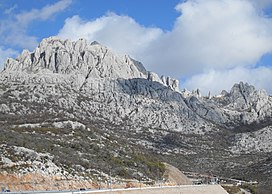This article needs additional citations for verification. (October 2010) |
| Velebit | |
|---|---|
 The Sveti Rok Tunnel passes underneath Velebit. | |
| Highest point | |
| Elevation | 1,757 m (5,764 ft) |
| Coordinates | 44°32′N 15°14′E / 44.533°N 15.233°E |
| Geography | |
 | |
| Location | Croatia |
| Parent range | Dinaric Alps |
Velebit (pronounced [v̞ɛlɛ̌bit]; Latin: Mons Baebius; Italian: Alpi Bebie) is the largest, though not the highest, mountain range in Croatia. The range forms a part of the Dinaric Alps and is located along the Adriatic coast, separating it from Lika in the interior. Velebit begins in the northwest near Senj with the Vratnik mountain pass and ends 145 km to the southeast near the source of the Zrmanja river northwest of Knin.
Its highest peak is the Vaganski vrh at 1,757 m.[1] Major mountain passes on Velebit include the aforementioned Vratnik or Senjsko bilo at 694 m.a.s.l.,[1] where the Josephina connects Senj with Josipdol; Oštarijska vrata at 928 m.a.s.l. that connects Karlobag and Gospić;[1] and Prezid at 766 m.a.s.l. that connects Obrovac and Gračac.[1]
Velebit is characterized by its simple, solid form, stiff cliffs, the lack of vegetation on the seaward side (towards the Velebit Channel), and the wood-covered slopes of the Lika side. The basic geological characteristic of the mountains is karst; flora and fauna are abundant. The whole mountain range is protected as a nature park. The most popular spots on Velebit are: the peak of Vučjak (1,644 m) above Zavižan, the botanical gardens and caves, Hajdučki and Rožanski kukovi, Štirovača, the Northern Velebit National Park and the Paklenica National Park.[2] The Croatian Meteorological and Hydrological Service has a permanent measurement station at Zavižan.[1]
- ^ a b c d e "Geographical and meteorological data" (PDF). Statistical Yearbook. Croatian Bureau of Statistics. 2009. Retrieved 2011-09-19.
- ^ Naklada Naprijed, The Croatian Adriatic Tourist Guide, pg. 140–141, Zagreb (1999), ISBN 953-178-097-8
